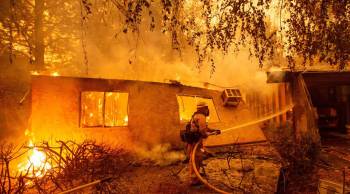Living in a wildfire zone
Hundreds of wildfires are burning in the West. The drought that’s dried out the region got the fire season started early, and so far, this is shaping up as one of the worst years ever in the Pacific Northwest.

Lieutenant Kurt Stich of Cowlitz 2 Fire and Rescue fights fire — and boulders, snakes and bee stings — on the south side of Lake Chelan in central Washington state.
But every year in the West there’s a fire season. Malibu, not many miles from the city of Los Angeles, has had so many wildfires that the writer Mike Davis wrote an essay called “The Case for Letting Malibu Burn.”
The community of Topanga sits deep in Topanga Canyon, in the Santa Monica Mountains, between Los Angeles and Malibu. It’s an old hippie haven. Neil Young even wrote and recorded most of “After the Gold Rush” there. It’s a beautiful place to live, but the scenery comes with a cost: worrying about nature.

More and more houses off Topanga Canyon Boulevard are being incorporated into the natural wildland.
Beth Burnham lives on 16 acres about a mile off the main road. She’s got a big house, and she and her husband have horses and chickens. They call it paradise, but this is also California — a land of natural disasters. They say they’re not worried about mudslides or flooding or even an earthquake.
“Fire is the devastating event that will happen out here,” she says.
It will happen. Topanga Canyon is full of chaparral — shrubs and trees adapted to a dry climate that burn explosively.
Two men work for Burnham, armed with chainsaws and weed trimmers, cutting back dead trees and brush.
This is maintenance. The hard work was done when Burnham bought the property 13 years ago. A crew worked for weeks cutting back the chaparral to create a clear area around her buildings.
It was expensive. But she knew it had to be done.
“I’m fortunate to have these guys, I’m fortunate to be able to pay them,” Burnham says. “It’s a balance. Most people don’t have these kinds of people or these kinds of tools. If a person has a gardener, it’s more of a typical mowing and watering — basically ‘blow and go.” But most people in Topanga don’t even have gardeners.”
Burnham would know. She’s co-president of the North Topanga Canyon Fire Safe Council. The group writes grants to help those residents without as much money make their homes safer.
For every multimillion dollar estate out here, there’s a little cabin built in the 1950s and ’60s. And Cal Fire maintains it’s the responsibility of individual homeowners to make their houses fire-safe.
Janet Upton, Cal Fire’s deputy director, says compliance is pretty steady. One problem the agency deals with now is timing, because clearing brush with power tools at the height of fire season can start fires.
“And so folks are well meaning, they listen to our prevention messages in the spring,” she says. “They think, ‘Mental note: I’ve got to do my clearance.’ And then they don’t get around to it.”
Ed Smith teaches at the University of Nevada-Reno and coordinates Nevada’s Living with Fire Program. He says clearing a defensible space around a house is imperative. But convincing homeowners to do it is another thing.
“There’s a variety of reasons why people don’t take action,” he says. “One of them is the aesthetics and the desire to live in a natural setting.”

Many people want a view of Lake Tahoe, so they’re reluctant to augment the natural landscape to make their homes fire-safe.
Smith said some people also just feel bad about cutting down a tree — even though that might save other trees.
“If a fire does occur, and the people in the community felt the same way, and you lose your forest, was that worth it?” he says.
Even those who do all they can to protect their home live with the realization that fire is going to come some day.
Which raises the question: Does it make sense to live out here?
Whether or not it makes sense, lots of people are moving closer to the wildlands. Over the last 25 years, about 2 million acres a year have been converted into what firefighters and experts call the wildland-urban interface: houses in the fire zone.
Scott Ferguson lives in a part of Topanga where his house is close to his neighbors. It’s landscaped with wooden staircases and paved pathways.
“Don’t sit there and worry about it, because if you’re going to worry about burning up, you should just move,” he says. “Because the reality is, it’s just something that’s there. It’s a possibility.”
Next month marks the 10-year anniversary of the Topanga Fire, which burned nearly 40 square miles and caused $16 million in damages. Beth Burnham says she spends a lot of her time thinking about that possibility.
“This is a community of somewhere between eight and 10 thousand people with one road, basically, in and out,” she says. “How are we all going to get out of here when the fire is coming down?”

The Topanga Fires of 2005 caused $15.8 million in damage to the area.
There’s a lot happening in the world. Through it all, Marketplace is here for you.
You rely on Marketplace to break down the world’s events and tell you how it affects you in a fact-based, approachable way. We rely on your financial support to keep making that possible.
Your donation today powers the independent journalism that you rely on. For just $5/month, you can help sustain Marketplace so we can keep reporting on the things that matter to you.


















